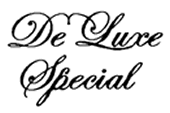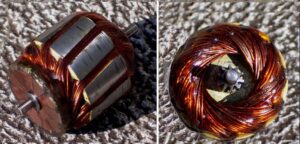A Fourteen Car Deluxe Special
By Walt Friauf TCA# 71-3936

In 1921 Ives discontinued 1 gauge trains (1-3/4”) and started making trains of 2-1/8” gauge. The flagship of Ives’ new line was the No. 704 train, pulled by the new 12 wheel 3243 electric locomotive which was a good model of the New York Central S class locomotives which hauled trains in and out of Grand Central Terminal in New York City. The 704 set included a buffet car, a parlor car, and an observation car. The Ives catalog description was quite prosaic at first but in 1926 the train was finally given a name, the Deluxe Special, and the catalog proclaimed it to be “by far the handsomest outfit made for boys.” The train was cataloged through 1928, with frequent modifications that allow accurate dating. Some of the more prominent changes were as follows:
1923 new window style on cars
1924 automatic reverse unit for locomotive
1925 6 wheel trucks for cars; brass plates on locomotive
1926 brass plates on cars
1927 wide motor; separate automatic reverse unit
1928 stamped frame for locomotive.
On a very rainy day in September 1979 I acquired a 1927 model 3243R engine and three 1925 model cars with rubber stamped lettering and 6 wheel trucks at a WB&A Chapter meet in Timonium, MD. Over the next two decades a number of units of custom rolling stock have been added to create a Super Deluxe Special. So let’s take a look at the two engines and 14 cars which comprise the train.
Due to the great increase in the number of cars, a helper engine is needed to double head the train. The 20 wheel 2-C+C-2 engine on the head end was custom built, patterned on a Cleveland Union Terminal prototype. A Lionel 8 cab was extended in length, height, and width, and modified in several other ways, painted black metal flake, lettered Ives 3247, and fitted with homemade operating pantographs. The power trucks are Lionel O gauge 6 wheel steam engine power units with the gauge widened, the number of laminations increased, and with 12 pole skew wound armatures turning in ball bearings replacing the original 3 pole armatures. The 3243R road engine is substantially in its original condition, but it had been repainted before I acquired it.
I replaced the driving wheels, and replaced the original armature with an 11 pole skewed armature with inserted form wound coils to give perfect symmetry, as shown here. The armature laminations for all the motors came from defunct appliances and the commutators were made from copper quarters.
Now we will start looking at the cars from right to left and from top down. The express refrigerator car is a modern G gauge plastic car that has been cut back in all 3 dimensions so as to be compatible in size with the Ives cars. Snake couplers and Ives long wheelbase 4 wheel trucks with journal boxes added have been substituted for the original components. Next comes a baggage car built from scratch in 1980, the first custom car chronologically. It was made of wood and cardboard to represent a wood prototype car. Ives 4 wheel passenger car trucks were converted to 6 wheels with the aid of Franceschetti epoxy trim and wheels with the flanges removed for the center pair.
The result is almost indistinguishable from Ives 6 wheel trucks, although the wheelbase is slightly shorter. The baggage-mail car is a Lionel 1767 raised about 1/4” on its original 6 wheel trucks. It has been lengthened a little and modified otherwise to match the Ives cars, and provided with a new roof and snake couplers. The combine was originally an Ives buffet car with early style windows. Four small windows at the front end were filled in and the diaphragms were modified to match those on late style cars. The trucks were converted to 6 wheels as on the baggage car. You may have guessed that I like 6 wheel trucks.
Next comes a coach that was originally an early style parlor car. Its trucks and diaphragms were modified as discussed above. In addition, the car body was so beat-up that it had to be unsoldered and cut up quite a bit to get it straightened out. During re-assembly the two little end windows on each side were moved together at one end, as they were located originally on the combine. Next comes a café-coach made from another early style buffet car by reworking the baggage end considerably. The other side is quite a bit different and includes a sliding door in the café section. Then come two more coaches although only one is shown above. They were both originally early style parlor cars. The windows were left in their original configuration and the trucks and diaphragms were modified as discussed above, but otherwise they are unchanged except for repainting and re-lettering. Finally in this figure is the dining car which was a late style buffet car modified extensively in 1982, with complete interior trim added.
The lounge car is a late style observation car with the platform end enclosed and a homemade Pullman style roof to replace the missing Ives roof. The sides were modified to make the length come out right. The parlor car from 1925 is in its original condition except for a roof repaint. Its original black window frames set it apart a bit from all the other cars which have red window frames. Then comes another parlor car in the 14 car train, but it does not appear above. The Pullman sleeping car is a late style parlor car except with a homemade Pullman style roof in place of the original Ives roof which was used on one of the coaches. The car was repainted and named “WYACONDA” after the real Pullman car that I headed off to college on way back in 1945. The observation car is in its original condition except for marker lights and an illuminated rear platform sign which I added. The sign has the lettering shown at the top of this article.
Most of the cars that were customized were pretty much junkers that needed repairs and repainting, and usually quite a few replacement parts such as doors, steps, roofs, truss rods, or couplers that I made in my basement shop. The helper engine alone with its twin 12 pole motors can handle 12 cars, so that both engines together can easily pull 14 cars.













